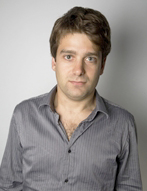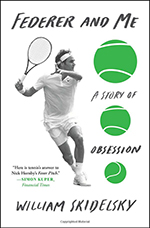The Curse of Nadal
William Skidelsky
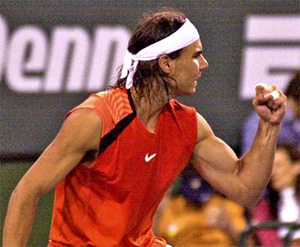
A blot appeared on the otherwise sunny vista that stretched before Federer in 2004-2006, and it took the form of a preternaturally muscled Spaniard. Like most diehard Federer fans, I loathe Rafael Nadal.
I cannot stand the man or his tennis. In my more reflective moments, I am capable of admitting that this attitude falls short of perfect objectivity. Nadal, I am prepared to concede, may not be a wholly despicable human being. But no amount of ordinary decency can make up for the grave offense that he has committed, and continues to commit, simply by existing. This alone is enough to make him loathsome, unforgivable.
Yet those inclined to castigate Nadal for more run-of-the-mill failings do not lack material to work with. The list of the Spaniard's negative attributes is obvious and extensive. Going through it provides its own grim satisfaction: in our most abject moments, we Federer fans need something to hang on to.
Standing at the apex of the edifice of his odiousness is the attention he pays to his gluteus maximus, which he once described--as if this explained things--as being "bigger than normal."
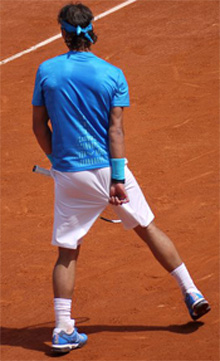
His dislodgement, prior to each point, of a (presumably?) phantom wedgie is as weird as it is unsavory, and has the unfortunate effect of conjuring up an image that I--and no doubt others--would prefer not to have to contemplate.
If the shorts tugging thing were Nadal's only quirk, that would be off-putting enough. But it's just one element in a smorgasbord of tics. In the entire history of sport, has there ever been an athlete more flagrantly OCD than Nadal, one more neurotically in thrall to his rituals and compulsions?
Every second he spends on court, other than when the ball is in, play, is minutely preprogrammed, robotized. Before each coin toss, he undertakes the exact same sequence of actions involving the meticulous laying down of his personal effects (tournament ID placed face up next to his bag, which is positioned on a towel), the removal of his jacket (always facing the crowd, always accompanied by jumping), and the ingestion of a packet of energy gel (always in four squeezes).
While walking around the court, he scrupulously avoids the lines, stepping over them right foot first. At changeovers, he unfailingly waits for his opponent before rounding the net post, and is never the first to leave his chair. He positions his two water bottles (one warm, one chilled) in exactly the same place, labels pointing towards the end he's about to play from.
As a point approaches, the obsessiveness ratchets up a notch: the tennis writer Greg Garber identified twelve distinct phases to Nadal's pre-serve preparation, including toweling down in a particular way, wiping the baseline with his shoes and then, as he bounces the ball with his racket, sequentially touching his shirt, nose, and hair. The entire ritual, according to Garber, can last (depending on the importance of the point) 27-31 seconds, which explains why Nadal frequently is in violation of the between points time rule.
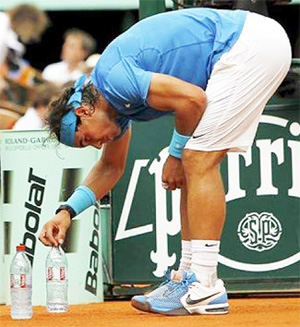
All this, moreover, is just the visible peak of the iceberg--the stuff that the public gets to see. There's also what happens behind closed doors.
In his memoir, Nadal alludes to the "inflexible routines" he settles into before each match, which include an unvarying meal of sauceless pasta and plain fish and personally putting the grips on each of his six Babolat Aero Pro Drive rackets. Forty-five minutes before play, he takes a freezing cold shower: "It's the first step in the last phase of what I call my pre-game ritual." (Which raises the question: just how many "phases" does this particular ritual have?)
Lleyton Hewitt, commentating on one of Nadal's matches at the 2014 Australian Open, described the Spaniard repeatedly taking his shirt off and on before leaving the locker room. Hewitt was heavily criticized for divulging this.
Nadal's compulsions seem potentially limitless; where does such behavior end? Is the prematch ritual itself preceded by a pre-prematch ritual? At what point, following a victory, do preparations for the next match begin? Is any portion of Nadal's life not under the sway of some compulsion? Is the man capable of relaxing? (To read John Yandell's take on other Rafa behaviors that intimidated Roger at the 2007 French, Click Here.)
In his memoir, Nadal writes that the goal of his rituals is to "silence the voices in my head." The aim is to "bottle up" all "human feelings," thereby turning himself into a "tennis machine."
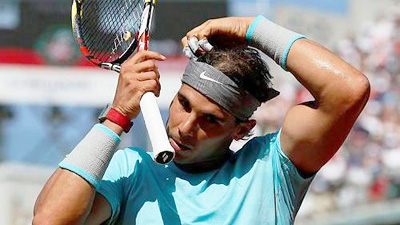
In this sense, there's a continuity between his mental approach to tennis and the way he plays the sport, because, on court, Nadal is certainly' machinelike. His game is founded not on surprise or variation but on the principle of eternal repetition.
Throughout his career, Nadal's strategy has been to find what works and then keep doing it over and over, never deviating from the script. His tennis, like his whole life, is based on denial and self-negation--on resisting the temptation to do what comes naturally.
Writing about the buildup to the 2008 Wimbledon final, he describes visualizing his game plan: "I have to be centered, no distractions, do what I have to do in each moment. If I have to hit the ball twenty times to Federer's backhand, I'll hit it twenty times, not nineteen.
"If I go up to the net, I hit it to his backhand, not to his drive. Losing your concentration means going to the net and hitting the ball to his forehand, or omitting in a rush of blood to serve to his backhand--always to his backhand-or going for a winner when it's not time.
"Being concentrated means keeping doing what you know you have to do, never changing your plan, unless the circumstances of a rally or of the game change exceptionally .It means discipline, it means holding back when the temptation arises to go for broke."
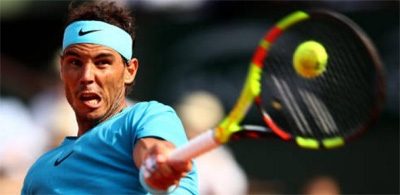
This is about as close to Stoicism as a sporting philosophy can get. Having deployed his tics and rituals to quash his "human feelings," Nadal is able to play the tennis of an automaton, relentlessly, joylessly sticking to his "plan."
Quite aside from his personality and playing style, a third avenue of Nadal opprobrium is open to Federer fans in the unedifying facts of the Spaniard's biography. No successful tennis career ever seems preordained--the odds are always stacked against the boy growing up to become a champion.
But in Nadal's case, the path to greatness proved especially rocky and obstacle-laden. His life teems with crossroads and turning points--moments where, had the stars been aligned differently, his dreams of greatness might have been snuffed out. For Federer fans, such moments are painful to contemplate.
In the first place, he was born in Mallorca on June 3, 1986. Couldn't his parents have delayed the event by a few years?
He was right-handed. Ninety-nine times out of a hundred--in fact, nine hundred and ninety-nine times out of a thousand-right-handed children grow up to be right-handed tennis players. But not Nadal.
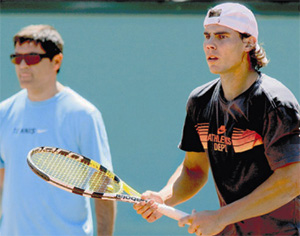
Uncle Toni, Nadal's stony-faced coach, who bears a sizable portion of the blame for every Nadal-related ill in the world took it upon himself, when Nadal was ten, to force his charge to play left-handed. He did this solely because he reckoned it would make his nephew a more awkward opponent.
It is impossible not to have a certain grudging respect for the sheer courage, and diabolical prescience, of this decision, which could, after all, have catastrophically backfired. What if, aged fifteen, Nadal had realized that he would never make it as a lefty?
Having missed several critical years of right-handed development, his career would have already been finished. Aged twelve, Rafa approached another fork in the road: football or tennis? He was gifted at the former, and it was even more the family sport than tennis.
Another uncle, Miguel Angel, was a Spanish international. How welcome in retrospect Spain would have been to Rafa's footballing talents! But alas he opted for tennis. Since turning pro, too, Nadal has repeatedly flirted with oblivion. In his late teens, he suffered a mysterious recurring stress fracture in his left foot, which twice forced him to take lengthy time-offs, including the entire clay court season in 2004.
After a succession of doctors had pronounced themselves baffled, a specialist in Madrid finally diagnosed the problem. Nadal had a rare congenital condition that had caused a bone in the bridge of the foot, the tarsal scaphoid, to become deformed. There was a serious risk that he'd never play competitively again.
Not surprisingly, he was shattered. "I'd lie for hours on the end of the sofa staring into space, or sit in the bathroom, or on the stairs, weeping. I didn't want to talk. I lost all appetite for life."
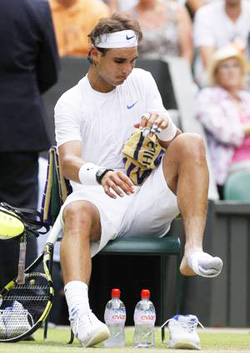
Nadal's only hope, the specialist said, was to tinker with the soles of his tennis shoe, in the hope of cushioning the defective area. Amazingly, this far-fetched-seeming solution worked: Nike devised a "wider and higher" shoe, and Nadal was soon back on court.
Since then, while his ankle has rarely troubled him, the rest of his body has proved anything but sturdy. Twice, he has been forced out for months by tendonitis in the knees. He has suffered blisters, groin strains, shoulder strains, back spasms.
A right-wrist injury led to a three-month layoff in 2014. Then no sooner had he returned than he came down with appendicitis. Every few months, it seems, a new bodily infirmity reveals itself, a fresh locus of weakness. Physically, Nadal seems permanently on the brink of collapse.
Yet the thing about him is that he never does collapse. He goes away, recuperates, and then--incredibly--comesback stronger. With Nadal, it's always the same: that odd combination of fallibility and fortitude; an endlessly repeated cycle.
Down in a rally, he comes up with an impossible pass. Down in a match, he raises his game to new heights. His powers of rebound are freakish, unprecedented; the man is unbreakable, immovable, unputdownable.
You almost feel that, if his body weren't as creaky as it is, he'd start inflicting injuries upon himself, merely to reproduce the conditions of adversity in which he flourishes. Perhaps this is ultimately the point of his rituals: they're not so much to silence the voices in his head as to place yet another obstacle in his path.
There has never been a champion more burdened than Nadal, one who makes winning appear less straightforward. The crown rests heavily on his head. And although I know it doesn't reflect well on me to say it, this makes me dislike him all the more.



